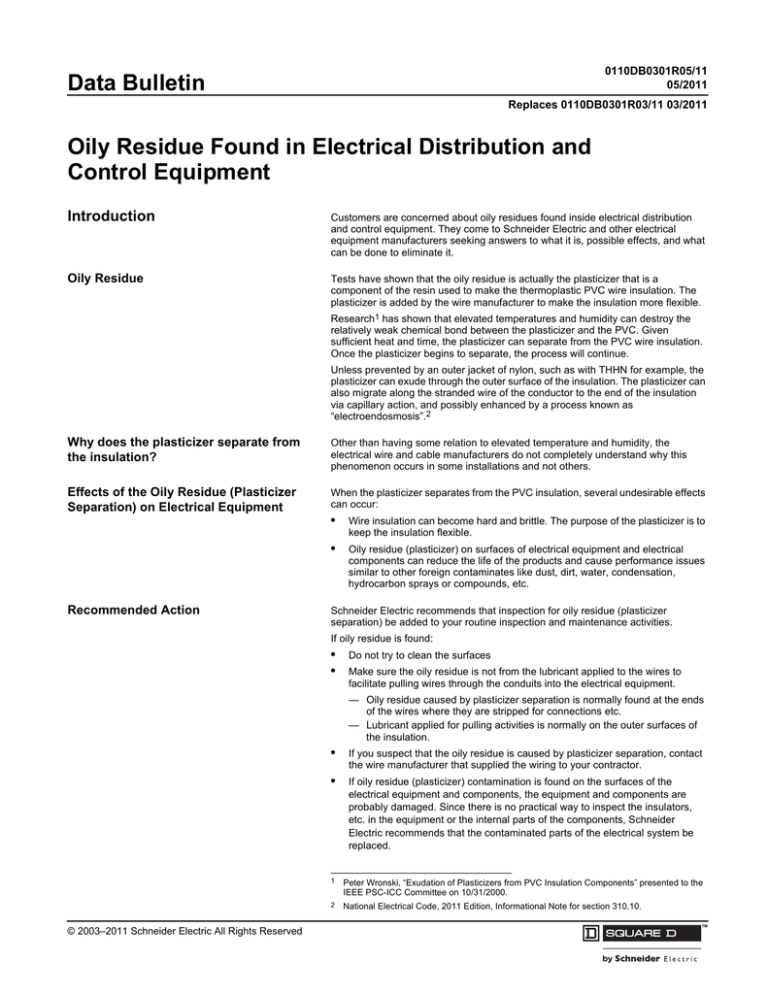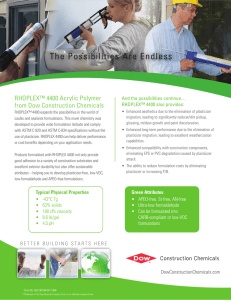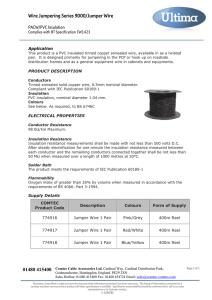
0110DB0301R05/11
05/2011
Data Bulletin
Replaces 0110DB0301R03/11 03/2011
Oily Residue Found in Electrical Distribution and
Control Equipment
Introduction
Customers are concerned about oily residues found inside electrical distribution
and control equipment. They come to Schneider Electric and other electrical
equipment manufacturers seeking answers to what it is, possible effects, and what
can be done to eliminate it.
Oily Residue
Tests have shown that the oily residue is actually the plasticizer that is a
component of the resin used to make the thermoplastic PVC wire insulation. The
plasticizer is added by the wire manufacturer to make the insulation more flexible.
Research1 has shown that elevated temperatures and humidity can destroy the
relatively weak chemical bond between the plasticizer and the PVC. Given
sufficient heat and time, the plasticizer can separate from the PVC wire insulation.
Once the plasticizer begins to separate, the process will continue.
Unless prevented by an outer jacket of nylon, such as with THHN for example, the
plasticizer can exude through the outer surface of the insulation. The plasticizer can
also migrate along the stranded wire of the conductor to the end of the insulation
via capillary action, and possibly enhanced by a process known as
“electroendosmosis”.2
Why does the plasticizer separate from
the insulation?
Other than having some relation to elevated temperature and humidity, the
electrical wire and cable manufacturers do not completely understand why this
phenomenon occurs in some installations and not others.
Effects of the Oily Residue (Plasticizer
Separation) on Electrical Equipment
When the plasticizer separates from the PVC insulation, several undesirable effects
can occur:
Recommended Action
•
Wire insulation can become hard and brittle. The purpose of the plasticizer is to
keep the insulation flexible.
•
Oily residue (plasticizer) on surfaces of electrical equipment and electrical
components can reduce the life of the products and cause performance issues
similar to other foreign contaminates like dust, dirt, water, condensation,
hydrocarbon sprays or compounds, etc.
Schneider Electric recommends that inspection for oily residue (plasticizer
separation) be added to your routine inspection and maintenance activities.
If oily residue is found:
•
•
Do not try to clean the surfaces
Make sure the oily residue is not from the lubricant applied to the wires to
facilitate pulling wires through the conduits into the electrical equipment.
— Oily residue caused by plasticizer separation is normally found at the ends
of the wires where they are stripped for connections etc.
— Lubricant applied for pulling activities is normally on the outer surfaces of
the insulation.
© 2003–2011 Schneider Electric All Rights Reserved
•
If you suspect that the oily residue is caused by plasticizer separation, contact
the wire manufacturer that supplied the wiring to your contractor.
•
If oily residue (plasticizer) contamination is found on the surfaces of the
electrical equipment and components, the equipment and components are
probably damaged. Since there is no practical way to inspect the insulators,
etc. in the equipment or the internal parts of the components, Schneider
Electric recommends that the contaminated parts of the electrical system be
replaced.
1
Peter Wronski, “Exudation of Plasticizers from PVC Insulation Components” presented to the
IEEE PSC-ICC Committee on 10/31/2000.
2
National Electrical Code, 2011 Edition, Informational Note for section 310.10.
™
Oily Residue Found in Electrical Distribution and Control Equipment
Data Bulletin
0110DB0301R05/11
05/2011
FAQs
Q I have found an “oily” appearing substance on some of the insulators, circuit
breakers, terminal blocks, etc. on some of my electrical equipment. What is
this stuff?
A See the explanation under “Oily Residue”.
Q I have also found that some of the insulators in my electrical equipment have
deteriorated, or are falling apart. Why is this, and what is causing it?
A The plasticizer used in the manufacturing of the wire insulation is typically a
hydrocarbon based petroleum derivative. This type of petroleum derivative will
cause deterioration of some types of insulating materials commonly used by
manufacturers of electrical equipment.
Q Why is the “oily” plasticizer coming out of the wire insulation?
A We suggest you contact the wire manufacturer for more information. Based
upon reports to us, the problem seems to be more prevalent with circuit wires
running up a distance above the electrical equipment. Longer runs of wire also
seem to experience the greatest loss of the plasticizer. Heat and humidity tend
to accelerate the loss of the plasticizer.
Q Why does the “oily” substance appear only in the equipment and not on the
surface of the wires?
A Typical wire insulation is THHN or THWN. This type of wire insulation has an
outer jacket of nylon. The plasticizer cannot migrate or penetrate through the
nylon jacket so it runs down the strands of the wire until it reaches a point
where it can escape. This point is normally where the wire insulation has been
stripped away from the conductors.
Q Is it typical for wire to lose the plasticizer such as we are seeing?
A No, to our knowledge that does not seem to be typical; however the wire
manufacturer should be contacted for more specific information.
Q How does the “oily” substance get all over the circuit breakers, insulators,
and other parts of the electrical equipment?
A The plasticizer will tend to continue to migrate over other parts through
surface tension.
Q What should I do if I discover this condition of “oily” substance on or in my
electrical equipment?
A Follow the “Recommended Action” section of this Bulletin (above).
Schneider Electric USA, Inc.
3700 Sixth St SW
Cedar Rapids, IA 52404
1-888-778-2733
www.schneider-electric.us
2
Electrical equipment should be installed, operated, serviced, and maintained only by
qualified personnel. No responsibility is assumed by Schneider Electric for any
consequences arising out of the use of this material.
Square D™ and Schneider Electric™ are trademarks or registered trademarks of
Schneider Electric. Other trademarks used herein are the property of their respective
owners.
© 2003–2011 Schneider Electric All Rights Reserved



